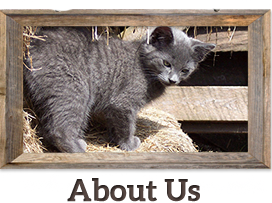Library
-
Quality of life is a way to refer to and discuss the day-to-day life and lifestyle of a dog reaching the end of its life. A quality-of-life scale for cats can help owners and veterinarians work together to maintain a healthy human-animal bond. The scale looks at seven different categories including hurt, hunger, hydration, hygiene, happiness, mobility, more good days than bad. The scale can help clarify the decisions and anxiety related to your dog’s end of life care.
-
Rabbits can make wonderful pets for those willing to understand their unique characteristics and needs. They are very intelligent and always adorable, but require special handling and more supervision than some other pet species. As it is with all pets, though, rabbits require a healthy diet, lots of activity, social interaction, and routine veterinary care to live happy and healthy lives.
-
Rabies is one of the most devastating viral diseases affecting mammals, including dogs and humans. It is a fatal disease caused by infection with the rabies virus. Following a bite from a rabid animal, the disease progresses in stages. Vaccination is the cornerstone of rabies prevention.
-
Rabies is one of the most devastating viral diseases affecting mammals, including dogs and humans. It is a fatal disease caused by infection with the rabies virus. Following a bite from a rabid animal, the disease progresses in stages. Vaccination is the cornerstone of rabies prevention.
-
Most cats care for their kittens with little need for human intervention; if they do not, then their caregivers need to step in. It is critical to maintain a warm environment and ensure they receive enough milk. Kittens’ weight should be checked daily in the first two weeks and any prolonged crying should be investigated. Feeding can be supplemented with commercial milk replacer if needed. Further feeding and vaccination recommendations are discussed. Contact your veterinarian for specific instructions.
-
Most dogs care for their puppies with little need for human intervention; if they do not, then their caregivers need to step in. It is critical to maintain a warm environment and ensure they receive enough milk. Puppies’ weight should be checked daily in the first two weeks, and any prolonged crying should be investigated. Feeding can be supplemented with commercial milk replacer if needed. Further feeding and vaccination recommendations are discussed. Contact your veterinarian for specific recommendations.
-
A RAST test, or radioallergosorbent test, is a blood test that can be used to determine which allergens are causing a pet's allergies. This test is often performed as part of the workup for atopic dermatitis in cats. The results of allergy testing are typically used to develop a hyposensitization plan for your cat, which helps desensitize your cat to allergens. Many cats treated with hyposensitization, formulated on the basis of RAST results, experience a significant reduction in the signs of allergic dermatitis.
-
A RAST test, or radioallergosorbent test, is a blood test that can be used to determine which allergens are causing a pet's allergies. This test is often performed as part of the workup for atopic dermatitis in dogs. The results of allergy testing are typically used to develop a hyposensitization plan for your dog, which helps desensitize your dog to allergens. Many dogs treated with hyposensitization, formulated on the basis of RAST results, experience a significant reduction in the signs of allergic dermatitis.
-
Observant, devoted, and lively, Ratties make great companions and family dogs. They love to play, but they want to be with you, so they suit families who want a friend and playmate.
-
Feeding raw food to cats is potentially dangerous - not only to the cat eating the raw food, but also to other pets and humans in the environment, due to the high likelihood of bacterial contamination. Raw food may also not be complete and balanced and could lead to nutrient deficiencies or toxicities. Consuming raw food with bones can lead to life-threatening foreign body obstruction.


